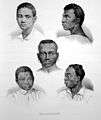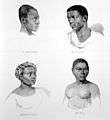Afro-Brazilian history
| Afro-Brazilian topics |
|---|
| Afro-Brazilian history |
| Religion |
| Culture and music |
The history of Afro-Brazilian people spans over five centuries of racial interaction between Africans imported, involved or descended from the effects of the Atlantic slave trade.
African origins
The Africans brought to Brazil belonged to two major groups: the West African and the Bantu people.
The West African people (previously known as Sudanese, and without connection with Sudan) were sent in large scale to Bahia. They mostly belong to the Ga-Adangbe, Yoruba, Igbo, Fon, Ashanti, Ewe, Mandinka, and other West African groups native to Guinea, Ghana, Benin, Guinea-Bissau and Nigeria. The Bantus were brought from Angola, Congo region and Mozambique and sent in large scale to Rio de Janeiro, Minas Gerais, and the Northeastern Brazil.
The blacks brought to Brazil were from different ethnicities and from different African regions.Gilberto Freyre noted the major differences between these groups. Some Sudanese peoples, such as Hausa, Fula and others were Islamic, spoke Arabic and many of them could read and write in this language. Freyre noted that many slaves were better educated than their masters, because many Muslim slaves were literate in Arabic, while many Portuguese Brazilian masters could not even read or write in Portuguese. These slaves of greater Arab and Berber influence were largely sent to Bahia. Even today the typical dress of the women from Bahia has clear Muslim influences, as the use of the Arabic turban on the head.
Despite the large influx of Islamic slaves, most of the slaves in Brazil were brought from the Bantu regions of the Atlantic coast of Africa where today Congo and Angola are located, and also from Mozambique. In general, these people lived in tribes. The people from Congo had developed agriculture, raised livestock, domesticated animals such as goat, pig, chicken and dog and produced sculptures in wood. Some groups from Angola were nomadic and did not know agriculture.[1]
| Estimated disembarkment of Africans in Brazil from 1781 to 1855[2] | ||||
|---|---|---|---|---|
| Period | Place of arrival | |||
| Total in Brazil | South of Bahia | Bahia | North of Bahia | |
| Total period | 2.113.900 | 1.314.900 | 409.000 | 390.000 |
| 1781–1785 | 63.100 | 34.800 | ... | 28.300 |
| 1786–1790 | 97.800 | 44.800 | 20.300 | 32.700 |
| 1791–1795 | 125.000 | 47.600 | 34.300 | 43.100 |
| 1796–1800 | 108.700 | 45.100 | 36.200 | 27.400 |
| 1801–1805 | 117.900 | 50.100 | 36.300 | 31.500 |
| 1806–1810 | 123.500 | 58.300 | 39.100 | 26.100 |
| 1811–1815 | 139.400 | 78.700 | 36.400 | 24.300 |
| 1816–1820 | 188.300 | 95.700 | 34.300 | 58.300 |
| 1821–1825 | 181.200 | 120.100 | 23.700 | 37.400 |
| 1826–1830 | 250.200 | 176.100 | 47.900 | 26.200 |
| 1831–1835 | 93.700 | 57.800 | 16.700 | 19.200 |
| 1836–1840 | 240.600 | 202.800 | 15.800 | 22.000 |
| 1841–1845 | 120.900 | 90.800 | 21.100 | 9.000 |
| 1846–1850 | 257.500 | 208.900 | 45.000 | 3.600 |
| 1851–1855 | 6.100 | 3.300 | 1.900 | 900 |
Note: "South of Bahia" means, "from Espírito Santo to Rio Grande do Sul"; "North of Bahia" means, "from Sergipe to Amapá".
-

African slaves from Mozambique
The travel
Slave trade was a huge business that involved hundreds of ships and thousands of people in Brazil and Africa. There were officers on the coast of Africa that sold the slaves to hundreds of small regional dealers in Brazil. In 1812, half of the thirty richest merchants of Rio de Janeiro were slave traders. The profits were huge: in 1810 a slave purchased in Luanda for 70,000 réis was sold in the District of Diamantina, Minas Gerais, for up to 240,000 réis. With taxes, the state collected a year the equivalent of 18 million reais with the slave trade. In Africa, people were kidnapped as prisoners of war or offered as payment of tribute to a tribal chief. The merchants, who were black Africans too, took the slaves to the coast where they would be purchased by agents of the Portuguese slave traders. Until the early 18th century such purchases were made with smuggled gold. In 1703, Portugal banned the use of gold for this purpose. Since then, they started to use products of the colony, such as textiles, tobacco, sugar and cachaça to buy the slaves.[3]
In Africa, about 40% of blacks died in the route between the areas of capture and the African coast. Another 15% died in the ships crossing the Atlantic Ocean between Africa and Brazil. From the Atlantic coast the journey could take from 33 to 43 days. From Moçambique it could take as many as 76 days. Once in Brazil from 10 to 12% of the slaves also died in the places where they were taken to be bought by their future masters. In consequence, only 45% of the Africans captured in Africa to become slaves in Brazil survived.[3] Darcy Ribeiro estimated that, in this process, some 12 million Africans were captured to be brought to Brazil, even though the majority of them died before becoming slaves in the country.[4]
Slavery in Brazil
Brazil obtained 37% of all African slaves traded, and close to 4 million slaves were sent to this one country.[5] Starting around 1550, the Portuguese began to trade African slaves to work the sugar plantations once the native Tupi people deteriorated. During the colonial epoch, slavery was a mainstay of the Brazilian economy, especially in mining and sugar cane production.
Muslim slaves, known as Malê in Brazil, produced one of the greatest slave revolts in the Americas, when in 1835 they tried to take the control of Salvador, Bahia. The event was known as the Malê Revolt.[1]
Abolition of slavery
The Clapham Sect, a group of Victorian Evangelical politicians, campaigned during most of the 19th century for England to use its influence and power to stop the traffic of slaves to Brazil. Besides moral qualms, Brazilian slavery hampered the development of markets for British products, which was a main concern of British government and civil society. This combination led to intensive pressure from the British government for Brazil to end this practice, which it did by steps over several decades. Slavery was legally ended May 13 by the Lei Áurea ("Golden Law") of 1888.
Post-slavery
By the time of slavery's end, Afro-Brazilians faced a number of cultural challenges, both state-sponsored and societal. Among them, a long-established discriminatory immigration policy made sure that previously large minorities of the African ex-slaves and large majorities of them and their direct descendants, mainly in Southern and Southeastern Brazil, were already being replaced by white European immigrants, from many origins; this was furthered by a national doctrine of racial "whitening" (or Portuguese: branqueamento), whereby miscegenation was encouraged by the state to breed out the darkest-skinned Afro-Brazilians. Besides the immigration and natal policies, the state, under President Fonseca in 1890, also revived a slavery-era ban on capoeira which lasted until the 1930s under dictator Getúlio Vargas. There was also a ban on Afro-Brazilian religions, and the first criminalization of cannabis use in Brazil was due to its association with the culture of the African slaves. Overpopulation caused uncontrolled rural exodus and urbanization and lack of infrastructure to assist the masses combined of the perpetuation of historical racial discrimination resulted in the contemporary enormous social problems caused by income disparities seen even nowadays in Brazil, which led to other negative stereotypes about the Afro-Brazilians perpetuating their condition as social outcasts.
The end of the Brazilian dictatorship in 1985 brought much more civil liberties and eventually the criminalization of racist propaganda, humiliation, harassment and discrimination; but there are still many important issues such as income gap, wage disparity, social perpetuation of racial stereotypes, crime and police brutality, sexism and religious intolerance (which can be even led by Afro-Brazilian Protestants themselves against followers of Afro-Brazilian religions).
Cultural revival
Beginning in the 1970s, in the midst of the military dictatorship, Afro-Brazilians were inspired by the previous decade of the Civil Rights movement in the United States. This was first evidenced in the incorporation of funk, soul music and Jamaican reggae with samba and increasingly political lyrics to create hybrid genres of popular music in Brazil, but by the 1980s, a more ethnically aware political movement, aligned both with the Black Power movement in the United States and the Caribbean as well as the Pan-African movement in Africa, developed through such ideologues as Abdias do Nascimento. Today, a plethora of social, cultural and political organizations have been organized to draw attention to racially aggravated ills caused by past government policies and social practices and the Brazilian government took a more proactive stance on ethnic and racial diversity under President Lula da Silva.
See also
References
- 1 2 Freyre, Gilberto. Casa-Grande e Senzala, Vol. 51, 2006.
- ↑ IBGE. Brasil: 500 anos de povoamento. Rio de Janeiro: IBGE, 2000. Apêndice: Estatísticas de 500 anos de povoamento. p. 223 apud Desembarques no Brasil (visitado em 23 de agosto de 2008)
- 1 2 [Gomes, Laurentino. 1808]
- ↑ Darcy Ribeiro. O Povo Brasileiro, Vol. 07, 1997.
- ↑ Negros IBGE Archived October 7, 2009, at the Wayback Machine.



